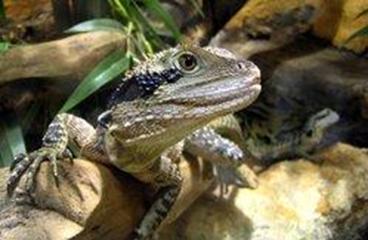


|
Diapsida:
Diapsids ("two arches") are a group of tetrapod animals that developed two holes (temporal fenestra) in each side of their skulls, about 300 million years ago during the late Carboniferous period. Living diapsids are extremely diverse, and include all birds, crocodiles, lizards, snakes, tuataras, and possibly even turtles. While some lost either one hole (lizards), or both holes (snakes), they are still classified as diapsids based on their ancestry. There are 14,600 species of diapsid existing in environments around the world today, including most flying and poisonous vertebrates. The ancestral openings are above and below the eye, and allow the jaw to open wider, and the attachment of larger, stronger jaw muscles. A more obscure ancestral characteristic is a relatively long lower arm bone (radius), compared to the upper arm bone (humerus). Extinct groups include the dinosaurs, pterosaurs, plesiosaurs, mosasaurs, and many more obscure lineages. The classification of most of the early groups is fluid and subject to change. The salient features of the Subclass Diapsida are:
1.Two temporal fossae are present on each side of the skull.
2.The post-orbital and squamosal meet between the two temporal fossae.
This subclass is divided into two superclass:
1.Lepidosauria 2.Archosauria |
